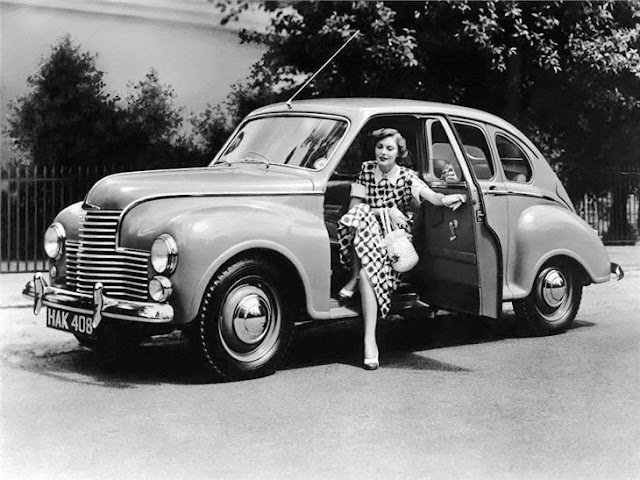Fenders generally were still separate elements that were partly blended into the main body. The trend also was for the front fenders to edge toward and ultimately merge with or supplant rear fenders. Roof line fashion in America just before Pearl Harbor was the so-called "fastback" style where the roof line descended in a smooth curve from the passenger compartment across the trunk down to the rear bumper. These evolutionary trends were in the direction of a body shape resembling a teardrop with provision for a hood and with a windshield behind it.
Curtailed automobile production during the war gave stylists time to reconsider all this. General Motors, at the time the production and styling leader in America, opted postwar for continuation of the fender trend, but fastback styling largely yielded to "bustle back" designs where the roof curve ended in front of the trunk hinge line, the trunk area being a distinct part of the body. Postwar GM designs included some two-door fastback models, but the style was phased out in the early 1950s.
Other car makers forged ahead postwar with the thought that the prewar styling trends would continue. The result was a variety of rather clumsy designs, especially for six-window sedans, few of which did well in the marketplace.
I discuss these and other evolutionary styling trends in this book.
Here are some of those cars that missed the postwar style change.
Tatra 600 Tatraplan - 1948
The Tatra 600 was a Czech car introduced in 1946 that was a follow-on to a prewar series of automobiles with their engines mounted at the rear. All such Tatras embodied the teardrop streamlining philosophy of design, so their styling people probably felt that they were already ahead of the rest of the industry as the war ended.
Jowett Javelin - c.1947
The Jowett Javelin was an early postwar British car with advanced styling and engineering features. Some of the inherent heaviness of fastback 6-window styling was avoided by designer Gerald Palmer because he retained separate fenders. But the Jowett company failed due to engine teething problems and corporate under-capitalization that prevented riding out the troubles.
Standard Vanguard c.1947
Less successful design-wise was another British car, the Standard Vanguard. Here the through-fender design coupled with a high roof line and steep fastback curve made for a heavy looking car in spite of its comparatively small size.
Ford SAF Vedette - 1949
If the Ford SAF Vedette looks a lot like a 1949 Mercury, that's because its features were intended to be used on a compact Ford model. Standard size Fords were at first intended to have the body eventually used by Mercury. This plan was rejected. Standard Fords got a smaller, different body and the body intended for the compact Ford was instead adapted by Ford's French subsidiary for the new Vedette line. The result wasn't as heavy looking as some 6-window fastbacks because the roof was fairly low.
Lincoln Cosmopolitan - 1949
Untouched by Ford's postwar body juggling was the Lincoln Cosmopolitan, which came in both fastback and bustle back guises. The fastback is pictured here. Thin door posts helped to lighten the design, but the Cosmo was a massive car to start with, and the fastback feature made it seem even heavier. Not many fastback Cosmos were sold, so the design was soon eliminated from the product mix.
Nash Ambassador Custom - 1949
Nash was lucky that its 1949-1951 "upside-down bathtub" styling didn't kill the company. It had all the features expected from prewar trends, even including front wheels enclosed by the body for improved aerodynamics (which did wonders for the car's turning radius).
Hotchkiss-Grégoire - early 1950
The conservative French manufacturer Hotchkiss took a radical postwar step with its Hotchkiss-Grégoire model featuring front-wheel drive and fastback styling. The car shown above was an early model with six side windows, a feature soon replaced by a 4-window version. Fenders are discrete rather than flow-through. The car is low thanks to the lack of a drive line, so its appearance isn't as heavy as it might have otherwise been.
Borgward Hansa 2400 - c.1952
Yet another awkward 6-window fastback was the German Borgward Hansa 2400 that was introduced several years after the others shown here. By then its styling was distinctly old-fashioned, so sales were poor.







